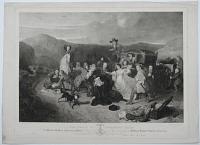
The Death of Archbishop Sharp. To Sir Walter Scott of Abbotsford Bart. this Print from the original Picture in the possession of William Lockhart Esq.r of Germiston, Is respectfully dedicated by his obliged Servants, William Allan & James Stewart.
Painted by William Allan. Engraved by James Stewart.
London, Published April 3.d 1824 by Hurst, Robinson & Co. 90 Cheapside & 8, Pall Mall.
Copper engra with large margins. 480 x 640mm, 19 x 24¼".
The assassination of Archbishop Sharp by a band of Covenanters in 1679 on Magus Muir, outside St Andrews. Jailed during the Interregnum, Sharp was appointed Archbishop of St Andrews in 1661, just after the Restoration of Charles II. Despite being Presbyterian he sides with Charles against the Covenanters he had formerly represented, enforcing policies such as the Act of Supremacy (1669) which gave the King complete authority over the Church. After the Battle of Rullion Green in 1666 he is reported as having condemned to death eleven prisoners who had surrendered on a promise of mercy, telling them 'You were pardoned as soldiers, but you are not acquitted as subjects'. Such was his unpopularity in Scotland that when a group of Covenanters waiting to ambush the Sheriff of Cupar found Sharp instead they wasted no time in putting him to the sword, in front of his young daughter. This painting is hardly sympathetic to the Covenanters, who are depicted as ruffians, just as interested in looting the luggage as killing the defenceless Sharp. This conflicts with the Scottish perception of heroes dispatching a turncoat in league with the Devil.
[Ref: 24582] £260.00
(£312.00 incl.VAT)
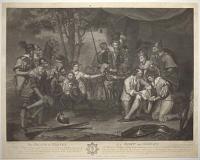
The Death of Sydney. S.r Philip Sidney mortally wounded (the victorious) at the battle of Zutphen; being extremely thirsty, asked for water, but as he was going to drink it, he saw a poor wounded Soldier half expiring, casting up a wishful look to it; instantly without tasting it, he gave it to him, saying, here honest fellow take it, thy wants are greater than mine.
GCarter pinxit. J. Jones fecit.
London Publish'd as the Act Directs Oct.r 21, 1782 by Gcarter Margaret Street, Cavendish Square.
Mezzotint, Sheet 485 x 620mm (19 x 24½"). Trimmed to plate.
Sir Philip Sidney (1554-1586), poet and courtier, was shot in the thigh fighting the Spanish at the Battle of Zutphen (22nd September 1586), dying of gangrene three weeks later. Interred in the Old St. Paul's Cathedral, his grave was lost in the Great Fire of 1666.
[Ref: 54256] £280.00
(£336.00 incl.VAT)
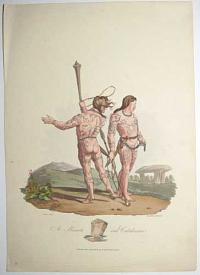
A Maæata and Caledonian.
C.H.S.[Charles Hamilton Smith] del.t. Aquatinted by R.Havell.
Published June 1st, 1815 by R.Havell, 3 Chapel Street, London.
Fine coloured aquatint. 245 x 340mm. Trimmed into plate top and bottom.
Two tribesmen of ancient Scotland showing off their tattoos, standing before a monument of standing stones and a lintel. In the title area is a vignette of an archaeological artifact. The Maeatae lived around the Firth of Forth and were regularly paid off by the Romans to keep the peace. The Caledonians lived further north, around Loch Ness. Published in the 'Costume of the Original Inhabitants of the British Islands', the first attempt to to use archaeological evidence to help create visual images of an imagined prehistoric past. Abbey Life 427.
[Ref: 59202] £130.00
(£156.00 incl.VAT)
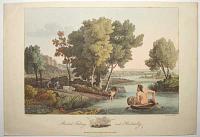
British Fishing, and Husbandry.
C.H.S.[Charles Hamilton Smith] del.t. Aquatinted by R.Havell.
Published June 1st, 1815 by R.Havell, 3 Chapel Street, London.
Fine coloured aquatint. 245 x 340mm (9¾ x 13½"). Trimmed into plate top and bottom.
Ancient Britons fishing from coracles and ploughing using ox. In the title area is a vignette of a plough, based on an archaeological artifact. Published in the 'Costume of the Original Inhabitants of the British Islands', the first attempt to to use archaeological evidence to help create visual images of an imagined prehistoric past. Abbey Life 427.
[Ref: 59201] £95.00
(£114.00 incl.VAT)
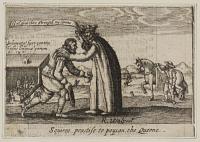
Squires practise to poyson the Queene.
[Friedrich von Hulsen.]
[Published by Humphrey Robinson & Robert Mylbourne.] [n.d. c.1630.]
Etching and engraving. 76 x 107mm (3 x 4¼"). Cut; false margins added.
Cut from Page 199 from George Carleton, 'A Thankfull Remembrance of Gods Mercy', with an illustration showing Edward Squire receiving a blessing from a Jesuit; in the background to right Squire applies poison to the pommel of the saddle of the Queen's horse. BM Satires: 13 (cf.); for another illustration from the same book, see ref. 12298
[Ref: 28946] £60.00
(£72.00 incl.VAT)
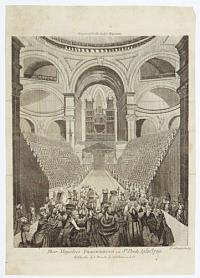
Their Majesties Procession in St Pauls, Ap.l 23d 1789. Engraved for the Lady's Magazine.
Prattent sculp
Pub.d as the Act Directs by G. Robinson & Co.
Engraving, sheet 245 x 175mm (9½ x 7"). Creased as normal.
Thanksgiving service held at St Paul's Cathedral on 23 April 1789 to mark the recovery of George III from illness. The king had been seriously ill before, in 1765, and the onset of severe illness late in 1788 led to a mad-doctor, Dr Francis Willis, being brought in (his implements included a strait-jacket and a restraining chair). The political implications were dramatic, with the prospect of the Prince of Wales becoming regent and imposing radical changes to government, but on 17 February 1789, three days before the Regency Bill was due to take effect, it was announced that the king was convalescent.
[Ref: 44135] £70.00
(£84.00 incl.VAT)
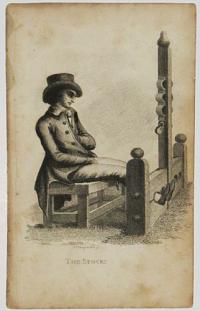
The Stocks.
J. Chapman sc.
[Published Jan. 1804 by James Cundee, Ivy Lane.]
Stipple. Sheet size: 140 x 85mm (5½ x 3¼"). Trimmed inside plate. Some staining.
A plate from 'The Criminal Recorder; or, Biographical Sketches of Notorious Public Characters', printed and published by James Cundee, Ivy Lane, London, illustrating the use of the stocks.
[Ref: 38043] £45.00
(£54.00 incl.VAT)
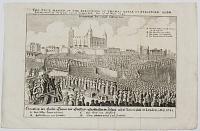
The True Maner of the Execution of Thomas Earle of Strafford, Lord Lieutenant of Ireland upon Tower hill, the 12th of May, 1641.
WH. [Monogram of Wenceslaus Hollar within plate.]
1641. Later.
Etching. Platemark: 185 x 260mm (7¼ x 10¼"). Vertical folds in the centre. Large margins.
A scene depicting the execution of Thomas Wentworth, Earl of Strafford (1593-1641), an English statesman and a major figure in the period leading up to the English Civil War. Crowds of spectators standing in wooden stands gather around, one of them collapsing in the distance, with a raised platform in the middle with the executioner holding an axe, Strafford, his kindred and friends, Bishop Usher and Sherriffs surrounding him. The Tower of London is in the background. Pennington, 552: III of III.
[Ref: 39353] £180.00
(£216.00 incl.VAT)
![[Execution of William Howard, 1st Viscount Strafford] Supplice du Vicount de Stafford.](img-thumbnail/jpegs/62304.jpg)
[Execution of William Howard, 1st Viscount Strafford] Supplice du Vicount de Stafford.
[n.d., c.1680.]
Etching. pt. 17th century watermark; Sheet 120 x 155mm (4¾ x 6"). Trimmed, mounted in album paper.
A scene depicting the execution of William Howard (1614-80), 1st Viscount Strafford, after being falsely implicated in ''Popish Plot'' by Titus Oates. His head is being held up for the crowd to see. The scene is taken from an engraving of the execution of Charles I; Strafford was executed on Tower Hill, not before Mansion house as here.
[Ref: 62304] £65.00
(£78.00 incl.VAT)
![[Trial of Thomas Wentworth, Earl of Strafford]](img-thumbnail/jpegs/42237.jpg)
[Trial of Thomas Wentworth, Earl of Strafford] [Abbildung der Session des Parlaments zu Londen uber den Sentenz des Grafen von Stafford.]
W Hollar fecit [c.1641]
Etching, sheet 240 x 270mm (9½ x 10½"). Trimmed, losing title above image; tipped into album sheet.
The trial of Thomas Wentworth, Earl of Strafford (1593-1641), lord lieutenant of Ireland. In the deteriorating political climate leading up to the English Civil War, Strafford was recalled to London by Charles I (whose great supporter he was) in 1640, but was accused of high treason and imprisoned in the Tower of London shortly after. Strafford was tried in March 1641 (the detailed trial scene here labels the prominent figures present) and demonstrated his great skill as an orator by refuting most of the charges against him (mostly relating to his conduct in Ireland). When these failed, the Commons passed a bill of attainder (an act of legislation declaring Strafford guilty and punishable by death). Charles I, who had previously sworn to protect Strafford, both appeared in person to ask for him not to be condemned to death, and sent soldiers to the Tower in an unsuccessful attempt to free him. Eventually Charles assented to the bill of attainder and Strafford was beheaded at Tower Hill (he was spared the traditional punishment for treason, of being hung, drawn and quartered). The death of Strafford, rather than resolving the tension between parliament and the monarchy, merely aggravated it, as the king could not forgive those who had forced him to abandon one of his most trusted aides. Etching by Wenceslaus Hollar (1607-77). Born in Bohemia, Hollar spent around 32 of his 52 years as a professional artist working in England. An outstanding draughtsman and topographical etcher, Hollar's enormously varied work has done much to inform the way that seventeenth century London is visualised. Pennington 551; for uncut impression offered with the Execution of Strafford see ref. 41634.
[Ref: 42237] £220.00
(£264.00 incl.VAT)
![[Trial of Thomas Wentworth, Earl of Strafford]](img-thumbnail/jpegs/42703.jpg)
[Trial of Thomas Wentworth, Earl of Strafford] Abbildung der Session des Parlaments zu Londen uber den Sentenz des Grafen von Stafford.
W Hollar fecit [c.1641].
Etching. 260 x 280mm (6¼ x 11"). Slight creasing.
The trial of Thomas Wentworth, Earl of Strafford (1593-1641), lord lieutenant of Ireland. In the deteriorating political climate leading up to the English Civil War, Strafford was recalled to London by Charles I (whose great supporter he was) in 1640, but was accused of high treason and imprisoned in the Tower of London shortly after. Strafford was tried in March 1641 (the detailed trial scene here labels the prominent figures present) and demonstrated his great skill as an orator by refuting most of the charges against him (mostly relating to his conduct in Ireland). When these failed, the Commons passed a bill of attainder (an act of legislation declaring Strafford guilty and punishable by death). Charles I, who had previously sworn to protect Strafford, both appeared in person to ask for him not to be condemned to death, and sent soldiers to the Tower in an unsuccessful attempt to free him. Eventually Charles assented to the bill of attainder and Strafford was beheaded at Tower Hill (he was spared the traditional punishment for treason, of being hung, drawn and quartered). The death of Strafford, rather than resolving the tension between parliament and the monarchy, merely aggravated it, as the king could not forgive those who had forced him to abandon one of his most trusted aides. Etching by Wenceslaus Hollar (1607-77). Born in Bohemia, Hollar spent around 32 of his 52 years as a professional artist working in England. An outstanding draughtsman and topographical etcher, Hollar's enormously varied work has done much to inform the way that seventeenth century London is visualised. Pennington 551; state iii of iii.
[Ref: 42703] £240.00
(£288.00 incl.VAT)
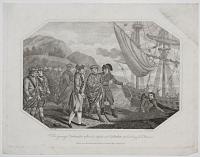
The young Pretender after his defeat at Culloden embarking for France.
Dodd delin. Grainger sculp.
Publish'd as the Act directs April 16, 1803: by J. Stratford. No.112, Holborn Hill.
Engraving and etching. 170 x 221mm (6¾ x 8¾"). Staining to upper right corner; offsetting to text.
Bonny Prince Charlie (1720-1788) being led into a rowing boat at right by two officers, a ship beyond, soldiers in highland dress surrounding at left. Illustration to Lyttleton's 'History of England' (London 1803-05).
[Ref: 27706] £65.00
(£78.00 incl.VAT)
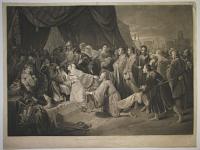
To Her Royal Highness Princess Charlotte Augusta This Plate of the Surrender of Calais, is, with permission, inscribed by her obliged and devoted Servant, John Young.
Painted by Edward Bird R.A. Engraved by John Young, Engraver in Mezzotinto to H.R.H. the Prince Regent.
London, March 1. 1817, by the Engraver, No. 65 Upper Charlotte Street Fitzroy Square.
Mezzotint, title in open letters, 570 x 750mm. Tatty and discoloured margins; plate generally good.
A dramatic scene. Queen Philippa on her knees before the throne of her husband Edward III, in his tent outside the walls of Calais, which he has reduced to surrender by seige (1447). She intercedes on behalf of the six citizens of the town who have come before him in chains as part of the ransom the king demanded. See Ref: 8628 for an early proof.
[Ref: 8374] £380.00
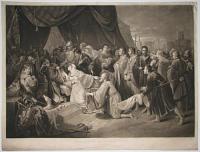
[To Her Royal Highness Princess Charlotte Augusta This Plate of the Surrender of Calais, is, with permission, inscribed by her obliged and devoted Servant, John Young.]
London, June 20th 1815 Published by John Young 65 Upper Charlotte St. Fitzy Sqe.
Mezzotint, proof with dotted publication line only, 570 x 750mm. Some folds and creases in margins; plate generally good.
A very fine early proof of this dramatic scene. Queen Philippa on her knees before the throne of her husband Edward III, in his tent outside the walls of Calais, which he has reduced to surrender by seige (1447). She intercedes on behalf of the six citizens of the town who have come before him in chains as part of the ransom the king demanded. See Ref: 8374 for a lettered impression.
[Ref: 8628] £520.00
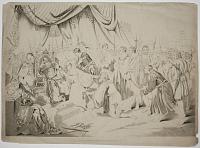
[To Her Royal Highness Princess Charlotte Augusta This Plate of the Surrender of Calais, is, with permission, inscribed by her obliged and devoted Servant, John Young.]
London, June 20th 1815 Published by John Young 65 Upper Charlotte St. Fitz.y Sq.e.
Engraving with roulette, preparatory proof before mezzotinting, dotted publication line. 530 x 730mm, 21 x 28¾". Edges frayed.
A very early proof of this dramatic scene, before any mezzotinting. Queen Philippa on her knees before the throne of her husband Edward III, in his tent outside the walls of Calais, which he has reduced to surrender by seige (1447). She intercedes on behalf of the six citizens of the town who have come before him in chains as part of the ransom the king demanded. See Ref: 8374 for the published state and 8628 for proof before full lettering.
[Ref: 24586] £180.00
(£216.00 incl.VAT)
![[The Humble Petition of the States Generall of the United Provinces]](img-thumbnail/jpegs/42793.jpg)
[The Humble Petition of the States Generall of the United Provinces]
W. Sherwin sc [1673]
Etching, rare; sheet 170 x 130mm (6¾ x 5"). Tipped into album sheet with small portrait.
The Independent Minister Hugh Peters (bap.1598-d.1660) introduces the four Dutch ambassadors Paulus van der Perre, Willem Nieupoort, Allard Peter Jongstall, and Hieronymus Berverningk to Secretary of State John Thurloe (bap.1616-d.1668). Beverningk presents a petition for peace during the First Anglo-Dutch War (1652-4). Thurloe was secretary of state from 1652-8 and his intelligence work both at home and abroad were crucial for the protectoral regime. He took part in negotiations with the Dutch ambassadors in autumn 1653 and thereafter he was the protectoral council's conduit to Nieupoort, the resident ambassador, and he was part of the negotiating team for the maritime treaty. Frontispiece to Henry Stubbe, 'A Further Justification of the Present War against the United Netherlands' (1673), published during the third Anglo-Dutch war (1672-4). For a portrait of Thurloe see ref. 24244.
[Ref: 42793] £240.00
(£288.00 incl.VAT)
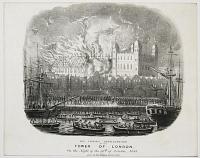
The Terrific Conflagration of the Tower of London, On the Night of the 30th of October, _ 1841. Loss to the Nation £10,000,000.
[n.d., c.1841.]
Lithograph. Sheet 210 x 260mm (8¼ x 10¼"). Trimmed into image at top and close to title at bottom.
The worst fire in the history of the Tower of London, destroying the Bowyer and Brick Towers and damaging the White Tower and the Chapel of St. Peter ad Vincula. The Martin Tower, where the crown jewels were kept, was threatened and, as the Keeper of the Jewel House had only the key, the security bars had to be bent to get in to save them. The uniform of the policeman who passed out the crown jewels was actually charred. Published in 'The Fly'.
[Ref: 49481] £95.00
(£114.00 incl.VAT)

Great Fire in the Tower of London, On the night of October 30th 1841.
R. Newman Litho.
Printed by Roberts & Co, 61 Eagle St, Holborn London.
Rare lithograph. Sheet 205 x 270mm (8 x 10¾"). Narrow margins.
A view of the Grand Armory on fire with soldiers in the courtyard tying to fight the fire. Some 60,000 items from the historical collection of armaments were destroyed.
[Ref: 56603] £140.00
(£168.00 incl.VAT)

The View of the Charity Children in the Strand, upon the VII of July, MDCCXIII, being the day appointed by her late Majesty Queen Anne for a Publick Thanksgiving for the Peace...
G.Vertue delin et sculpsit 1715. [but 1774].
Engraving on two sheets conjoined. Total 380 x 1260mm (15 x 49½"); large margins. Folds, as issued.
A large prospect of the Strand during the ceremonial procession celebrating the end of Britain's participation in the War of the Spanish Succession, sealed by the Treaty of Utrecht in 1713. Two stands hold 4,000 children, clothed for the occasion, girls on the left and boys on the right.
[Ref: 39005] £320.00
view all images for this item
![A faithful representation of the trial of her most gracious Majesti [sic] Caroline queen of england, in the house of lords 1820.](img-thumbnail/jpegs/24466.jpg)
A faithful representation of the trial of her most gracious Majesti [sic] Caroline queen of england, in the house of lords 1820. [French translation to right.]
[Anon., French or Italian, n.d., c.1820.]
Large and extremely scarce lithograph, sheet 525 x 575mm. 20¾ x 22¾". Several fold and handling creases, some reinforced with old backing strips to verso. Some soiling and light staining, generally tatty extremities, with closed tears and filled chip to lower right corner.
Depiction of the 1820 trial for adultery of Queen Caroline of Brunswick (1768 – 1821), wife of George IV. A realistic view of the House of Lords receding in perspective to the Throne, above which is inset an oval bust portrait lettered ‘Bartolomo [sic] Bergami’, wearing four decorations. Members of the House and others assembled around a large table at centre, upon which sits ‘13’, the ‘Green Bag’. Lord Chancellor John Scott, 1st Earl of Eldon presiding in middle ground, at centre; Queen Caroline can be seen seated in foreground to right. Lettered below the image with key, in English and French, identifying numbered figures and points of interest within the composition. This seems to be a Continental copy of a British print. When Caroline of Brunswick-Wolfenbüttel (1768 – 1821) arrived at St James's Palace the Prince of Wales came to visit her. After greeting her, he turned to the Earl of Malmesbury saying, 'Harris, I am not well. Pray get me a glass of brandy'. He then left the room. Caroline's comment to Malmesbury was , 'I find him very stout and by no means as handsome as his portrait'. The ill-matched pair were married on 8 April 1795 and it soon became clear that the Prince of Wales would not tolerate his wife's company unless he was drunk. The marriage was consummated and on 7 January 1796 a daughter, Charlotte, was born to the couple. By March, the proud parents were living separately and rarely spoke to each other. George's disastrous marriage to Caroline provided ample material for the caricaturists of the day. George was mocked for preferring his mistresses to his wife; Caroline received more sympathy but was rumoured to have a string of lovers and was easy to portray as a vulgar attention seeker. Tired of her husband's neglect, Caroline left England to tour Europe and in Italy met Bartolomeo Bergami who became her secretary and constant companion. The couple's relationship caused much scandal. See BM Satires 14004 for an anonymous cotton handkerchief of the same (English only) title.
[Ref: 24466] £500.00
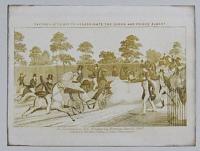
Oxford's Attempt to Assassinate the Queen and Prince Albert. On Constitution Hill, Wednesday Evening, June 10, 1840.
Published by H. Baker, 35, King St. Drury Lane, London.
Zinc engraving, rare. 115 x 152mm. 4½ x 6".
Scene on Constitution Hill, near Green Park, showing a man firing a pistol towards an open topped carriage carrying Queen Victoria and her husband, the horses drawing the carriage rearing up, a cloud of smoke from the end of the pistol. During Victoria's first pregnancy in 1840, in the first few months of the marriage, 18-year-old Edward Oxford attempted to assassinate her while she was riding in a carriage with Prince Albert on her way to visit her mother. Oxford fired twice, but either both bullets missed or, as he later claimed, the guns had no shot. He was tried for high treason and found guilty, but was acquitted on the grounds of insanity. See Collage: v8485528.
[Ref: 27975] £70.00
(£84.00 incl.VAT)
![[Visit of Louis Philippe of France to Windsor Castle, 1844.]](img-thumbnail/jpegs/58832.jpg)
[Visit of Louis Philippe of France to Windsor Castle, 1844.] Park's New Characters.
[n.d., c.1844.]
Rare coloured lithograph. Sheet 180 x 210mm (7 x 8¼"). Laid on album paper with other scraps, creased and stained.
A popular print depicting Victoria and King Louis Philippe sitting together on thrones, both wearing crowns, watched by Prince Albert. Louis-Philippe's week-long stay at Windsor in 1844 was the first meeting of the monarchs of Britain and France on English soil in half a millenia.
[Ref: 58832] £140.00
(£168.00 incl.VAT)
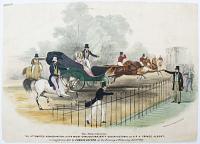
This Print represents the Attempted Assassination of Her Most Gracious Majesty Queen Victoria and H.R.H. Prince Albert, at Constitution Hill by Edward Oxford, on the Evening of Wednesday June 10th 1840.
Madeley, lith, 5, Wellington St, Strand.
[n.d., c.1840.]
Lithograph with hand-colouring, sheet 240 x 335mm (9½ x 13¼"). Creasing through centre and upper left.
The first attempt on Queen Victoria's life, showing the pregnant monarch and her husband travelling on Constitution Hill in a phæton, the Wellington Arch in the background, and Edward Oxford with his pistol raised. After firing two shots he was seized by onlookers. He was charged with treason, but, as no bullets could be found at the scene, it could not be proved his pistols had more than powder in them. He was found 'not guilty by reason of insanity' and sent to Bethlem asylum, where he was a model prisoner for nearly quarter of a century. In 1864 he was transferred to Broadmoor, still a model prisoner, and in 1867 it was decided to release him on the proviso he left the country and never returned. He left for Australia, where he changed his name to John Freeman, married, served as a churchwarden in Melbourne and published a book called Lights and Shadows of Melbourne Life in 1888. He died in 1900. Australian interest.
[Ref: 37659] £160.00
(£192.00 incl.VAT)
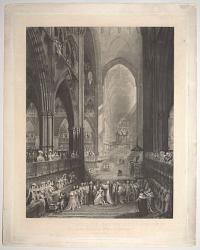
The interior of Westminster Abbey during the Coronation of Her most Gracious Majesty Victoria, June 28th 1838. Proof.
Engraved by George Saunders from a drawing made on the spot by Arthur Newcombe.
ondon, Published Sept. 1st. 1838 by Thos. Mclean 26 Haymarket.
Mezzotint, chine collé proof. 430 x 330mm (17 x 13"). Wear to backing paper and right edge of india.
A view of Westminster Abbey, with the Archbishop of Canterbury holding the crown over the Queen's head, the organ and the choir behind.
[Ref: 54671] £260.00
(£312.00 incl.VAT)
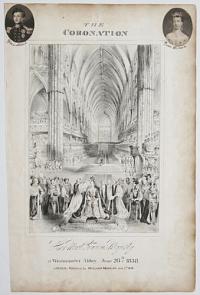
The Coronation of Her Most Gracious Majesty at Westminster Abbey, June 28th 1838.
London, Published by William Morgan July 3rd 1838.
Lithograph. Sheet: 235 x 365mm (9¼ x 14½"). Laid on an album sheet, two portraits stuck on top left and right corners with manuscript below.
A scene showing the coronation of Albert & Victoria.
[Ref: 44726] £65.00
(£78.00 incl.VAT)

The Coronation of her most Excellent Majesty Queen Victoria, On the 28.th June 1838.
London Published by R. Havell, 77, Oxford Street. [n.d. c1838]
Rare hand coloured aquatint. Sheet 340 x 535mm (13½ x 21"). Time stained. Some foxing. Small tear in right margin.
Interior of Westminster Abbey looking towards the organ and choir; foreground centre, the crowned Queen flanked by peers of the realm.
[Ref: 60457] £230.00
(£276.00 incl.VAT)
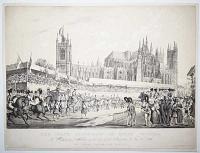
The State Procession of Queen Victoria, to Westminster Abbey on the day of the Coronation June 28.th 1838. The Guards Saluting her Majesty
[Drawn by J. S. Templeton] Printed by I.M Lefevre Newman St.
London: Published by William Spooner, 377, Strand. July 7.th 1838.
Very rare lithograph. Sheet 300 x 390mm (11¾ x 15½"). Mounted onto archival paper.
The state procession passing the temporary pavilions in front of Westminster Abbey en route to her coronation.
[Ref: 60458] £260.00
(£312.00 incl.VAT)

Panoramic Coronation Procession. From Drawings Taken On The Spot. [Queen Victoria [in pencil]].
Printed and Published by E. Elliot, 14, Holywell-st. Strand. [n.d. c.1838]
Wood engraving. Sheet 255 x 655mm (10 x 25¾"). Time stained. Creases where folded and previously folded as normal.
Panormic view of the state procession en route to Westminster Abbey.
[Ref: 60459] £160.00
(£192.00 incl.VAT)
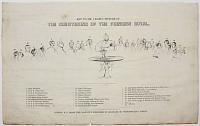
Key to Mr. Leslie's Picture of the Christening of the Princess Royal.
London: F.G. Moon, Her Majesty's Publisher in Ordinary, 20, Threadneedle Street.
Pen lithograph. Sheet: 255 x 410mm (10 x 16"). Trimmed and laid on an album sheet.
A keyplate to Leslie's painting of the christening of Victoria, the Princess Royal, on the 10th February 1841. Leslie was given special permission to attend the ceremony in order to capture the scene in sketches, he then spent time studying the portraits of the various figures over the coming months. The painting was finished in 1842 and an engraving was published in 1849. The work is still housed in the Royal Collection.
[Ref: 45923] £120.00
(£144.00 incl.VAT)
![[Vortigern and Rowena or the Settlement of the Saxons in Britain.]](img-thumbnail/jpegs/24990.jpg)
[Vortigern and Rowena or the Settlement of the Saxons in Britain.]
J.F. Rigaud R.A. Pinx.t F. Bartolozzi R.A. Sculp.t
London Publish'd Feb.y 14. 1788 by W. Palmer, No.163 Strand.
Stipple printed in red, proof before title. Plate 336 x 406mm. 13¼ x 16".
Vortigern was the Saxon King of Britain in 5 AD. He forged an alliance with brothers, Hengist and Horsa, who were given lands in Lincolshire in return for help in suppressing the Picts. The alliance was further enforced when King Vortigern fell in love with Renwein (or Rowena), the beautiful daughter of Hengist who agreed to their marriage in exchange for the whole of Kent. The scene captured here is clearly the banquet scene depicting the meeting of Vortigern and Rowena. The helmeted brooding figure of Hengist is seen seated on the left. Sometime later, in an attempt to bring all of Britain under Saxon control Vortigern arranged a meeting with Hengist, then King of the Jutes. However, Hengist armed his men who then massacred some 500 Saxon noblemen in an attack which became known as ‘the night of the long knives'
[Ref: 24990] £260.00
(£312.00 incl.VAT)
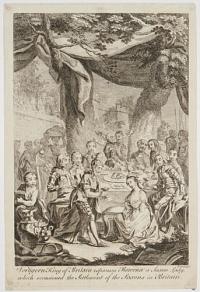
Vortigern King of Britain espouses Rowena a Saxon Lady, which occasioned the Settlement of the Saxons in Britain.
Ravenet fc.
[n.d. c.1770.]
Etching and engraving; paper watermarked, small margins. Plate 210 x 145mm (8¼ x 5¾"). Creasing.
The marriage of Vortigern and Rowena. Vortigern was the Saxon King of Britain in 5 AD. He forged an alliance with brothers, Hengist and Horsa, who were given lands in Lincolshire in return for help in suppressing the Picts. The alliance was further enforced when King Vortigern fell in love with Renwein (or Rowena), the beautiful daughter of Hengist who agreed to their marriage in exchange for the whole of Kent. Engraved by Simon Francois Ravenet (1704-74), who after moving from France to London worked for Hogarth (on his 'Marriage à la Mode') amongst others.
[Ref: 28944] £60.00
(£72.00 incl.VAT)
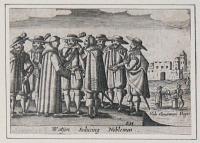
Watson seducing Noblemen.
F.H. [F. Hulsius sc.]
[From 'A Thankfull Remembrance of Gods Mercie' London: Printed by Aug. Math[ewes] for Robert Mylbourne and Humphrey Robinson, 1630.]
Engraving 73 x 108mm. Trimmed and laid on album paper.
William Watson, a Catholic priest, blessing a group of gentlemen involved in a plot against James I; in the backgound, one of them, Sir Griffin Markham, is pardoned at the point of execution. 1627. Hulsius or Friedrich von Hulsen (printmaker 1580 - 1665) Engraver; said to have been born in Middelburg, c. 1580. Son of Levis van Hulsen, mathematician and book-publisher in Ghent, and brother of Esaias van Hulsen. About 1592 the family moved to Nuremberg; in 1602 to Frankfurt where Frederik was probably a pupil of J T de Bry, and afterwards managed the family publishing house. 1627, in London briefly, where most of his work was connected with protestant propaganda. While in London he is most associated with book illustration as with these and others for George Carleton, 'A Thankfull Remembrance of Gods Mercy'. BM Satires 13 (cf.).
[Ref: 12298] £120.00
(£144.00 incl.VAT)
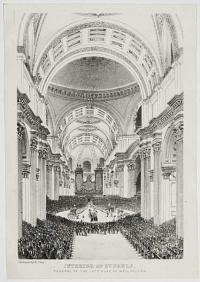
Interior of St. Pauls, Funeral of the Late Duke of Wellington.
On Stone by W. Clay.
[n.d. c.1852.]
Lithograph. 210 x 146mm. 8¼ x 5¾".
Interior view of St Paul's Cathedral during funeral service for Duke of Wellington, November 18, 1852, with the coffin laid in the centre. Field Marshal Arthur Wellesley, 1st Duke of Wellington (1769-1852) was one of only a handful of British subjects to be honoured with a state funeral, and was the last heraldic state funeral to be held in Britain. He was buried next to Lord Nelson in St Paul's Cathedral.
[Ref: 25180] £65.00
(£78.00 incl.VAT)
Unfortunately this item is either sold or reserved. If you are interested in similar items and cannot find what you're looking for on our website, please consider filling in our interests form. If you register, we can also send you items that match your interests when the website is updated.

Funeral Car of the Late Duke of Wellington.
Elliot. Holywell-street, Strand, London.
[n.d. c.1852.]
Woodcut with hand colour. Printed area 240 x 735mm (9½ x 29"). Original folds, creasing.
A popular print of the funeral car of Field Marshal Arthur Wellesley (1769-1852), 1st Duke of Wellington. A canopied carriage drawn by twelve black horses, it carried his body through London to St Paul's Cathedral where Wellington was laid next to Lord Nelson.
[Ref: 57586] £160.00
(£192.00 incl.VAT)

Funeral Car of the late Duke of Wellington.
Published by J.T. Wood, Holywell S.t.
Rare lithograph. 210 x 540mm, 8¼ x 21¼". Folded as issued, tears at centre fold.
The hearse of Arther Wellesley, 1st Duke of Wellington (1769-1852) on its way to St Paul's Cathedral, drawn by twelve horses. His was the last heraldic state funeral to be held in Britain.
[Ref: 17912] £130.00
(£156.00 incl.VAT)
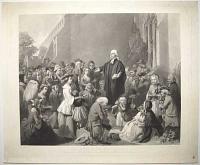
The Rev.d John Wesley, M.A., Preaching on his Father's Tomb-stone in Epworth Church-yard. Proof.
Painted by Alfred Hunt. Engraved by J.B. Hunt. Printed by J. Brooker.
London, William Tegg, 85, Queen Street, Cheapside. _ Darlington, Robert Swales, 8, High Row [n.d., c.1855].
Rare mixed-method engraving, proof printed on chine collé. 520 x 610mm (20½ x 24"), with large margins. Creases in india.
A young John Wesley preaching outside a church.
[Ref: 59284] £380.00
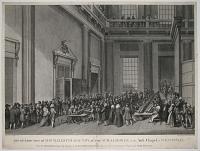
The Distribution of his Majesty's Maundy, by the Sub-Almoner in the Ante Chapel at Whitehall. From the Original Drawing in the possession of the Revd. Dr. Richard Kaye, Dean of Lincoln, F.R.S. and Trustee of the British Museum.
Drawn by S.H. Grimm 1773.,Engraved by James Basire, 1789.
Publish'd as the Act directs 23d. April 1789.
Etching, image 425 x 625mm. 16¾ x 24½". Trimmed within plate and into publication line. Three tears from extremities.
Interior of the Anti Chapel within the Banqueting House at Whitehall, Westminster, showing the distribution of the King's Maundy; figures sitting with food at long tables, standing by the doorway at left and on the balcony above. The building was designed by Inigo Jones and completed in 1622, it is the only remaining part of the old Whitehall Palace above ground. Engraved by James Basire after Samuel Hieronymus Grimm (1733 - 1794). Grimm's watercolour of 1773 is in the King's Topographical Collection at the British Library.
[Ref: 12764] £280.00
(£336.00 incl.VAT)
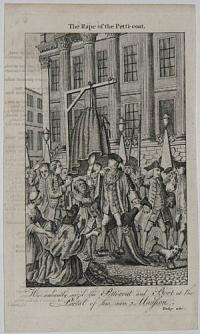
The Rape of the Petti-coat. He valiantly seiz'd the Petti-coat and Boot at the Portal of his own Mansion. Daily adv.
[Oxford, 1768.]
Etching, offset, sheet 125 x 200mm. 5 x 8". Slight offsetting.
Lord Mayor Thomas Harley is shown removing a petticoat and boot from a gallows erected outside the Mansion House in the City of London. A satire on Harley's personal intervention to subdue a riot after the election of John Wilkes (1727-797) as Radical MP for Middlesex in 1768. From 'The Oxford Magazine'. BM Satires 4190.
[Ref: 17208] £50.00
(£60.00 incl.VAT)
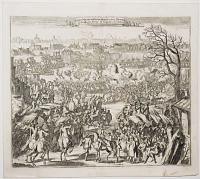
Einzug Wilhemi Henrici Prinzen von Orange zukunfftigen königs in England etc. in Londen
[n.d., c.1698.]
Engraving. Plate: 305 x 365mm (12 x 14½''). Central crease as normal.
A print showing a view of William of Orange's arrival in London in 1688, following the Glorious Revolution in which the Catholic James II was deposed in favour of his Protestant daughter and her husband. Canons are fired to mark the occasion, as the carriages rush by. In the foreground figures watch from behind a barricade, two try to climb over but are stopped by soldiers. From Merian's ''Theatrum Europaeum'' 1698.
[Ref: 49300] £320.00
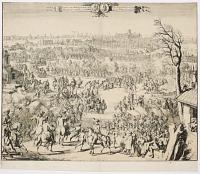
The Reception of His Royal Highness the Prince of Orange at his entring London.
R: de Hooge fecit.
[n.d., c.1688.]
Engraving. Sheet: 420 x 530mm (16½ x 21"). Trimmed and a false margin added to bottom edge. Light staining. Creases not visible from front.
A scene showing William of Orange, later William III being welcomed by a group of kneeling Lords, following William's invasion of England to take control of the crown during the Glorious Revolution. A large crowd forms around them and London can be seen in the distance. Langwehr: p149.
[Ref: 42940] £850.00
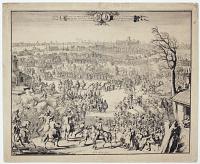
Receptie van S.K.H den H.Prince van Orange. op zyn intrede tot London. The Reception of His Royal Highness the Prince of Orange at his entring London.
R.de Hooge fecit.
[n.d., c.1690.]
Engraving. 455 x 550mm, large margins. Laid on card, a couple of marginal tears.
A scene showing the arrival of William of Orange in London, following his invasion of England. Landwehr, p.147, before their first state.
[Ref: 43077] £1,200.00
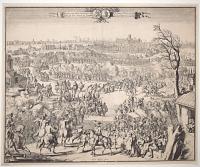
Receptie van S.K.H den H.Prince van Orange. op zyn intrede tot London. The Reception of His Royal Highness the Prince of Orange at his entring London.
R.de Hooge fecit.
[n.d., c.1690.]
Engraving. 440 x 535mm (17¼ x 21"). Trimmed and laid on archiving paper.
A scene showing the arrival of William of Orange in London, following his invasion of England. Ref: Landwehr 147.
[Ref: 55123] £680.00
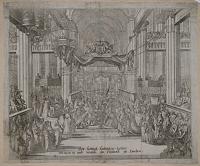
Der konigl: kronungs-Actus Wiliilmi III und Mariae in England, zu Londen.
[Merian, Theatrum Europaeum, 1698.]
Engraving, scarce. Plate 311 x 368mm. 12¼ x 14½". Very damaged and laid, paper loss on left.
William III (1650-1702) married Mary Stuart in 1677 and jointly ruled with her until her death in 1694. The period of their joint reign is referred to as "William and Mary". Here a depiction of the coronation of William III and Mary II. From 'Theatrum Europaeum", 1698.
[Ref: 23304] £120.00
(£144.00 incl.VAT)
![[Coronation of William III and Mary II at Westminster Abbey]](img-thumbnail/jpegs/42590.jpg)
[Coronation of William III and Mary II at Westminster Abbey] H. Mai. Willem III en Maria Gekroont tot Koning en Koningin van Engelant [...]
[Anon. Dutch, c.1689]
Etching, scarce; sheet 360 x 595mm (14¼ x 23½"). Creases.
The coronation of William III and Mary II at Westminster Abbey on 11 April 1689, with their portraits top left and top right. The Archbishop of Canterbury, William Sancroft, refused to sanction the removal of James II so the coronation was performed by the Bishop of London, Henry Compton.
[Ref: 42590] £580.00
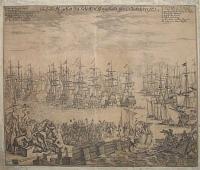
S.K.H Gehet zu Schiff in Engelland uber Zufahren.
[Frankfurt, heir of Matthaus Merian, c.1690.]
Engraving. Sheet 310 x 375mm (12¼ x 14¾"). Trimmed to printed border, laid on canvas, paper toned.
William of Orange landing at Torbay to a rapturous welcome, the Dutch fleet filling the bay. Published in the ''Theatrum Europaeum''.
[Ref: 55464] £350.00
![[Coronation of William III and Mary II at Westminster Abbey]](img-thumbnail/jpegs/42588.jpg)
[Coronation of William III and Mary II at Westminster Abbey] de Krooning van haare Majesteyten Willem de III en Maria de II tot Koning en Koninginne van groot Brittanie [...]
[Anon. Dutch, c.1689.]
Etching, sheet 175 x 280mm (7 x 11"). Trimmed; folded through centre.
The coronation of William III and Mary II at Westminster Abbey on 11 April 1689. The Archbishop of Canterbury, William Sancroft, refused to sanction the removal of James II so the coronation was performed by the Bishop of London, Henry Compton.
[Ref: 42588] £190.00
(£228.00 incl.VAT)
![[Coronation of William III and Mary II, 1689]](img-thumbnail/jpegs/42801.jpg)
[Coronation of William III and Mary II, 1689] Ceremonien en Plechtigheden gebruikt in de Krooning van Willem Henrik, Prins van Oranje, en Marie Stuart [...]
[published by Carel Allard, c.1700]
Etching, sheet 245 x 295mm (9¾ x 11½"). Tipped into album sheet. Trimmed to border
The rapidly-arranged coronation of William III and Mary II, held on 11 April 1689 at Westminster Abbey and conducted by the Bishop of London, Henry Compton. The Archbishop of Canterbury, William Sancroft who would normally have performed the ceremony, refused to sanction the replacement of James II as king. Plate from a Dutch publication comprising twenty plates depicting key episodes from the Glorious Revolution.
[Ref: 42801] £290.00
(£348.00 incl.VAT)
![[Coronation of William III and Mary II]](img-thumbnail/jpegs/42868.jpg)
[Coronation of William III and Mary II] Der konigl: kronungs-Actus Wiliilmi III und Mariae in England, zu Londen.
[Merian, Theatrum Europaeum, 1698.]
Etching, rare; platemark 305 x 365mm (12 x 14¼"). Central fold as normal. Trimmed.
The coronation, at Westminster Abbey, of William III (1650-1702) and Mary II, in 1689. From 'Theatrum Europaeum", 1698.
[Ref: 42868] £350.00
![[Arrival of William III in the Hague, 1691]](img-thumbnail/jpegs/42806.jpg)
[Arrival of William III in the Hague, 1691] Intreede van William de III Koning van Groot Britanje, in s'Gravenhage, de 5 Februari 1691 [parallel text in French]
J. Luiken
Apud Carolum Allard cum Priv. ord. Holl. et Westvrisiae. [in image lower right]
Etching, 17th century watermark; sheet 250 x 295mm (9¾ x 11½"). Tipped into album sheet; central fold. Trimmed to border.
Procession led by William III during his visit to the Hague in 1691 (the first time he had returned to the Netherlands since being crowned king of England, Scotland and Ireland in 1688). In the background is a huge triumphal arch erected for the occasion. Plate from a Dutch publication comprising twenty plates depicting key episodes from the Glorious Revolution. For a view of the arch, from the same publication see ref. 42804.
[Ref: 42806] £260.00
(£312.00 incl.VAT)
![[Triumphal Arch erected for William III in the Hague]](img-thumbnail/jpegs/42803.jpg)
[Triumphal Arch erected for William III in the Hague] Eere Poort op de Plaatz, opgerecht voor Z:K:M: van Groot Britanje, 1691 [parallel text in Dutch]
Apud Carolum Allard cum Priv. ord. Holl et Westvrisiae.
Etching, sheet 250 x 295mm (9¾ x 11½"). Tipped into album sheet; central fold. Trimmed to border.
Huge triumphal arch erected in the Hague on the occasion of William III's visit in 1691 (the first time he had returned to the Netherlands since being crowned king of England, Scotland and Ireland in 1688). Plate from a Dutch publication comprising twenty plates depicting key episodes from the Glorious Revolution.
[Ref: 42803] £260.00
(£312.00 incl.VAT)








![[Execution of William Howard, 1st Viscount Strafford] Supplice du Vicount de Stafford.](img-thumbnail/jpegs/62304.jpg)
![[Trial of Thomas Wentworth, Earl of Strafford]](img-thumbnail/jpegs/42237.jpg)
![[Trial of Thomas Wentworth, Earl of Strafford]](img-thumbnail/jpegs/42703.jpg)




![[The Humble Petition of the States Generall of the United Provinces]](img-thumbnail/jpegs/42793.jpg)



![A faithful representation of the trial of her most gracious Majesti [sic] Caroline queen of england, in the house of lords 1820.](img-thumbnail/jpegs/24466.jpg)

![[Visit of Louis Philippe of France to Windsor Castle, 1844.]](img-thumbnail/jpegs/58832.jpg)







![[Vortigern and Rowena or the Settlement of the Saxons in Britain.]](img-thumbnail/jpegs/24990.jpg)













![[Coronation of William III and Mary II at Westminster Abbey]](img-thumbnail/jpegs/42590.jpg)

![[Coronation of William III and Mary II at Westminster Abbey]](img-thumbnail/jpegs/42588.jpg)
![[Coronation of William III and Mary II, 1689]](img-thumbnail/jpegs/42801.jpg)
![[Coronation of William III and Mary II]](img-thumbnail/jpegs/42868.jpg)
![[Arrival of William III in the Hague, 1691]](img-thumbnail/jpegs/42806.jpg)
![[Triumphal Arch erected for William III in the Hague]](img-thumbnail/jpegs/42803.jpg)